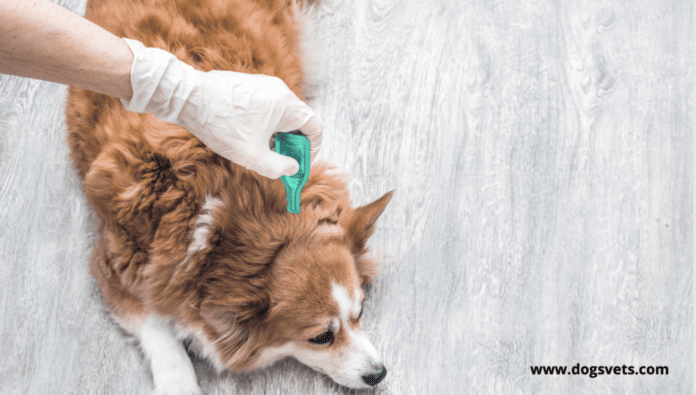Last Updated on November 4, 2022 by Dogs Vets
Why Do Dogs Get Ticks and Fleas
Fleas and ticks like to live on dogs because their fur is soft and warm. These insects rely on your pet’s blood and can cause allergies and tick-borne diseases.
Fleas and ticks are more widespread during the warmer months, but you may take preventative measures year-round.
Dogs usually get ticks because they walk through the woods or tall grass. Ticks do something called “questing,” which means they crawl up on low shrubs or grass, usually 18 to 24 inches off the ground, and hang out.
Here are the best flea treatments from FleaCures.com
Difference Between Fleas and Ticks
Fleas & ticks differ in many ways:
- Parasite type: Fleas are wingless insects with 6 legs capable of jumping. Ticks have 6 to 8 legs, just like spiders.
- The temperature range that they can survive in: Fleas survive best in summer months/warm environments. However, ticks survive in warm surroundings but are better acclimated to cold conditions, even hiding under the snow.
- The likelihood of fleas infesting your home: Most flea types have a greater chance of infesting your home. They may spread quickly, bring other insects, and invade your goods, furniture, and clothing. Ticks normally sit and wait for their host to pass by before attaching themselves to them.
Reasons Why Do Dogs Get Fleas
Most dogs will get fleas, frustrating their owners. The question is, why do dogs get fleas?
Fleas are a common problem since your pet can easily take them up from other pets or wildlife.

Contact with Other animals
When your dog goes outside and comes into touch with other animals, whether they are domesticated or wild, there is a good chance that it may pick up fleas.
As dogs are social animals, fleas can transfer from one dog to another.
Wild animals that transmit fleas are also likely to be present in open areas, which dogs find fascinating to explore.
Your Home
Fleas can quickly get into your house without being invited and make it their home. Fleas can take a ride into your home on people’s clothing, visiting pets, or wild nesting creatures, such as mice.
Keep in mind that flea infestations in homes can develop rapidly since a single adult female flea is capable of laying up to 40 eggs every day.
Pet Facilities
Your pet is more likely to pick up fleas in environments that are visited by other canines. There is no guarantee that fleas will not be present in dog daycare centers, grooming salons, or boarding kennels.
Fleas can readily enter these facilities since treatment differs from one dog owner to the next. Although these facilities have laws requiring dogs to be flea-free, these restrictions are sometimes quite harsh.
Outdoors
Dog fleas cannot be found living freely outside because they must spend their adult lives feeding on domestic pets or wild animals. However, dog flea eggs, larvae, and pupae can be found in warm, protected environments.
If you have a flea invasion in your home and your dog spends time outdoors (for example, in a kennel or car), these locations must also be treated to prevent recurrence infestations.
Warmer Climates
When you take the dog on vacation with you, they increase their risk of contracting various parasites and the diseases they carry. Because fleas can go longer without a host when temperatures are higher, they pose a greater threat in warmer areas. This makes flea infestations more dangerous in these areas.
Human Transportation
Humans can also carry fleas and ticks. Anyone who enters your house has the potential to bring fleas with them. They may have been brought in from the person’s own house or the person’s pet without consent.
If you hike in places with fleas and ticks, a few can catch a ride on your jeans, socks, shoes, etc. These parasites are adept at attaching to potential hosts to feed.
How to Identify a Tick on Your Dog
When ticks initially get on a dog, they’re little, dark brown, eight-legged insects. Once a tick is on a dog, it inserts its mouthparts in the skin and feeds on the dog’s blood. As a tick ingests blood, its belly grows, and its head and legs become hard to see.

While the tick is eating, infectious germs carried within its body are transferred into the host’s bloodstream.
You may also recognize the presence of ticks on your dog if you see any small welts or bruises resembling bite marks.
However, the presence of a tick still attached to your dog and feeding on it is by far the most prevalent sign of tick infestation.
Sometimes ticks may die if you use any medication, but they may still attach to your dog’s body coat/fur. Here’s how you can deal with dried dead ticks.
Flea and Tick Medication for Dogs
There are three distinct administration methods for flea and tick preventative medication that may be given to dogs. These are the following:
Oral Tablets
When treating fleas and ticks on dogs, oral tablets are an excellent option for both treatment and prevention. Oral tablets are safe but require a vet’s prescription.
Spot-on Flea Treatments
There are many different kinds of spot-on flea treatments, and their levels of efficacy can also vary.
A veterinary professional needs to suggest spot-on flea remedies to fulfil your dog’s specific treatment requirements related to fleas. If a spot-on flea treatment is correct for your dog, a vet will help you pick one at your next appointment.
Tick Collars
We propose tick collars if your dog’s lifestyle requires them. Ask your dog’s vet if this is a good treatment choice at your next appointment. The vets will be here to help you choose the finest flea and tick treatment for your dog.
How to Prevent Fleas From Coming Into Your Home
If dogs are coming over, ask the pet owner if their flea treatment is up to date, so fleas don’t get on your pets or into your home.
If you have rodents, you may need to get rid of them to prevent fleas.
- Use very hot water to clean all bedding, even that used for pets (ideally 50 degrees Celsius or above to kill adult fleas and their eggs)
- Thoroughly vacuum all carpets to assist in the removal of flea eggs, and then throw the vacuum bag away in an area that is not inside the house.
- Steam clean your carpet to kill flea larvae
Conclusion
We hope you enjoyed this article… What are your thoughts?
Please feel free to share this article!
e strive to provide the latest valuable information for pet lovers with accuracy and fairness. If you would like to add to this post or advertise with us, don’t hesitate reach us. If you see something that doesn’t look right, contact us!

















